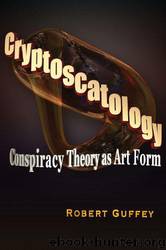Cryptoscatology: Conspiracy Theory as Art Form by Guffey Robert

Author:Guffey, Robert [Guffey, Robert]
Format: epub
ISBN: 9781936296408
Publisher: Trine Day
Published: 2012-05-31T16:00:00+00:00
Was Shakespeare a Freemason?:
Masonic Symbolism in Macbeth
In 1933 Past Master Alfred Dodd published a book that purported to contain evidence linking William Shakespeare with the creation of Freemasonry, an international secret society built around an interest in esoteric knowledge, including the ancient art of alchemy. In the book, Shakespeare: Creator of Freemasonry , Dodd focuses on the Masonic symbolism in two plays, Love’s Labours Lost and The Tempest . Except for two brief references he ignores Macbeth , an indispensable play in establishing Shakespeare’s ties to Freemasonry. The play appears to have been written as an allegory for the bloody murder of Hiram Abiff, the core figure of Masonic ritual.
Upon reaching the third degree the Masonic initiate is led through the mock ritual killing of Hiram Abiff, one of three original Grand Masters of Freemasonry. According to legend, Abiff had promised his architects that he would reveal to them all the secrets known by a Master Mason once the construction of Solomon’s Temple was completed. Three of the builders—Jubela, Jubelo, and Jubelum—were too impatient to wait and attacked Abiff, demanding to hear “the Master’s Word” immediately. Abiff refused, after which the three “unworthy craftsmen” committed the ultimate betrayal by killing their master (Robinson 218, 219).
From the previous paragraph alone one might notice the uncanny recurrence of the number three in Masonic ritual. In addition, not only are there three original Grand Masters, three assassins, and a total of thirty-three degrees of the Masonic hierarchy, but there are also three Principal officers, three symbolic steps “from this life to the source of all knowledge” (Downard, “Sorcery” 81), three obligations, three lights upon the Altar, three “pillars” that support the Lodge, and three knocks that gain the candidate admission into the Lodge, followed by three more knocks to summon the Brethren (Pike 548). This last example is paralleled in Act Two, Scene Three, where the porter utters the line “knock, knock, knock” twice until he allows entrance to Macduff, the future murderer of the “unworthy” Macbeth.
Both the number three and the concept of alchemy play an integral role in the story of Macbeth’s downfall. In Act One, Scene One, we are introduced to three witches who utter the words, “Fair is foul, foul is fair” (1110). James Shelby Downard has pointed out that this is a well known principal of alchemy. Just as lead can be transformed into gold, the ostensibly noble Macbeth and his wife can be transformed into serial murderers by greed and ambition. Macbeth and Lady Macbeth might be seen as deliberate representations of the mystical nagari, an androgynous dragon that symbolizes the alchemists’ ultimate goal of separating “the cosmic she and he” (Downard, “Call to Chaos” 309). Certainly, the Macbeths might be viewed as a warning to those who would take this separation to an extreme.
The number three appears again in relation to Hecate’s appearance in Act Three, Scene Five. Though some scholars attribute the authorship of this scene to a writer other than Shakespeare, nevertheless it’s interesting
Download
This site does not store any files on its server. We only index and link to content provided by other sites. Please contact the content providers to delete copyright contents if any and email us, we'll remove relevant links or contents immediately.
The Secret History by Donna Tartt(18819)
The Social Justice Warrior Handbook by Lisa De Pasquale(12128)
Thirteen Reasons Why by Jay Asher(8774)
This Is How You Lose Her by Junot Diaz(6764)
Weapons of Math Destruction by Cathy O'Neil(6122)
Zero to One by Peter Thiel(5665)
Beartown by Fredrik Backman(5578)
The Myth of the Strong Leader by Archie Brown(5407)
The Fire Next Time by James Baldwin(5229)
How Democracies Die by Steven Levitsky & Daniel Ziblatt(5113)
Promise Me, Dad by Joe Biden(5079)
Stone's Rules by Roger Stone(5015)
A Higher Loyalty: Truth, Lies, and Leadership by James Comey(4826)
100 Deadly Skills by Clint Emerson(4825)
Rise and Kill First by Ronen Bergman(4690)
Secrecy World by Jake Bernstein(4625)
The David Icke Guide to the Global Conspiracy (and how to end it) by David Icke(4609)
The Farm by Tom Rob Smith(4425)
The Doomsday Machine by Daniel Ellsberg(4402)
